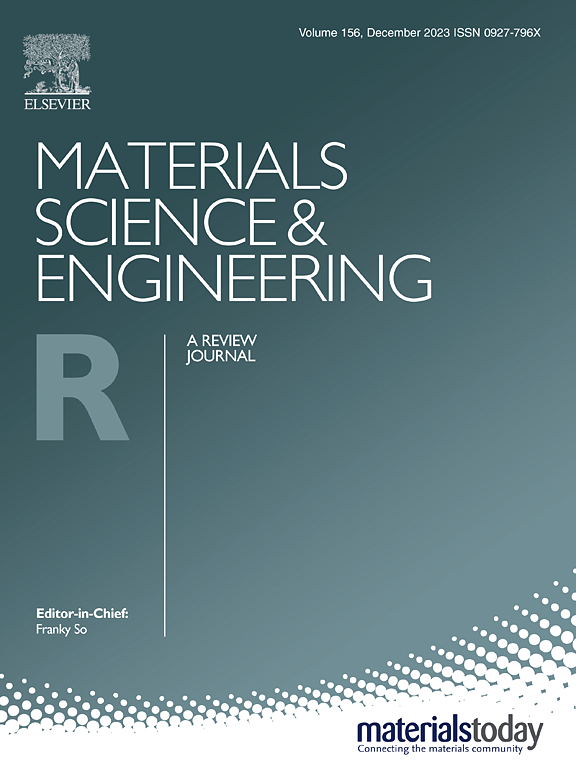超高效稳定的Janus界面,构建高性能硫化物基全固态锂金属电池
IF 31.6
1区 材料科学
Q1 MATERIALS SCIENCE, MULTIDISCIPLINARY
引用次数: 0
摘要
全固态锂金属电池(asslmb)因其优异的安全性和高能量密度,有望取代传统的锂离子电池。然而,金属锂与固体电解质之间的界面稳定性差是一个主要障碍。在这里,我们设计了一个具有“疏浚+阻塞”双重保护的稳定界面。该界面由复合锂阳极和功能化电解质组成。在锂离子镀/剥离过程中,杂化SEI界面的复合锂阳极具有良好的电子/离子导电网络,保证了电子在锂阳极中的快速传递,增强了锂的体扩散,起到了“疏通”锂离子分布的作用。当锂枝晶沿着电解质的颗粒间空间进一步生长时,特别是在高电流密度下,功能电解质可以作为第二保护线。通过与金属锂反应,消耗锂,并进一步形成稳定的界面,起到“阻断”锂枝晶生长的作用。因此,对称电池实现了稳定的循环(1400 h, 0.5 mA cm−2)和超高的临界电流密度(5.2 mA cm−2)。asslmb在宽温度范围内具有长循环性能(700次循环,70% %容量保留)和良好的速率性能。这种双改性策略显著提高了锂金属的相容性,为高性能asslmb的发展提供了一条可行的途径。本文章由计算机程序翻译,如有差异,请以英文原文为准。
Ultra-efficient and stable Janus interface to construct high-performance sulfide-based all-solid-state lithium metal batteries
All-solid-state lithium metal batteries (ASSLMBs) are expected to replace traditional lithium-ion batteries due to their excellent safety and high energy density. However, the poor interfacial stability between lithium metal and solid electrolyte is a major obstacle. Here, we design a stable interface with “dredging+blocking” dual protection. The interface is composed of a composite lithium anode and a functionalized electrolyte. During lithium-ion plating/stripping, the composite lithium anode of the hybrid SEI interface has a good electron/ion conductive network to ensure the rapid transmission of electrons in the lithium anode, enhance the bulk diffusion of lithium, and play a role in “dredging” the distribution of lithium ions. When lithium dendrites further grow along the interparticle space of the electrolyte, especially at high current density, the functional electrolyte can be used as a second protective line. By reacting with lithium metal, consuming lithium, and further forming a stable interface, it plays a role in “blocking” lithium dendrite growth. Therefore, the symmetrical battery achieves a stable cycle (1400 h, 0.5 mA cm−2) and an ultra-high critical current density (5.2 mA cm−2). ASSLMBs achieve long-cycle performance (700 cycles, 70 % capacity retention) and good rate performance in a wide temperature range. This dual modification strategy significantly enhances lithium metal compatibility, offering a viable path for the development of high-performance ASSLMBs.
求助全文
通过发布文献求助,成功后即可免费获取论文全文。
去求助
来源期刊

Materials Science and Engineering: R: Reports
工程技术-材料科学:综合
CiteScore
60.50
自引率
0.30%
发文量
19
审稿时长
34 days
期刊介绍:
Materials Science & Engineering R: Reports is a journal that covers a wide range of topics in the field of materials science and engineering. It publishes both experimental and theoretical research papers, providing background information and critical assessments on various topics. The journal aims to publish high-quality and novel research papers and reviews.
The subject areas covered by the journal include Materials Science (General), Electronic Materials, Optical Materials, and Magnetic Materials. In addition to regular issues, the journal also publishes special issues on key themes in the field of materials science, including Energy Materials, Materials for Health, Materials Discovery, Innovation for High Value Manufacturing, and Sustainable Materials development.
 求助内容:
求助内容: 应助结果提醒方式:
应助结果提醒方式:


